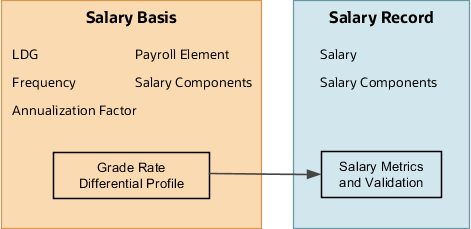Overview of Base Pay Configuration
Base pay is a person's salary amount. Managers and HR specialists view and adjust this amount or any component amounts or percentages over the time someone works in their organization. Each salary record they manage has an associated salary basis.
Here's how the salary basis configuration works with salary records and payroll processing.
- Calculations use the frequency and annualization factor of the salary basis to decide the annualized salary that appears on the salary record. Calculations also use these salary basis settings and the full-time equivalent value from the employment record to decide the annualized full-time salary.
- The salary record uses any salary components configured on the salary basis to itemize salary adjustments for reports, such as merit and location.
- The payroll element associated with the salary basis holds the salary amount entered on the salary record. The basis passes that amount to payroll for processing.
- The grade rate and differential profile associated with the salary basis decide the salary metrics and validation messages people see on the salary record. Associating them with the salary basis is optional, so they aren't part of every salary basis configuration.

You configure grades, grade rates, progression grade ladders, rate definitions, and payroll elements using the Base Pay task list in the Compensation work area. You can also manage lookups, actions, and action reasons.